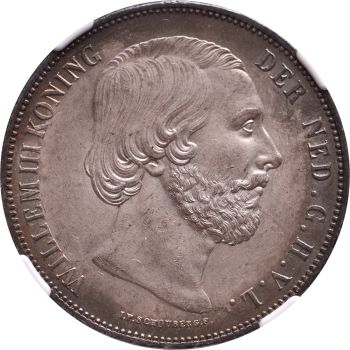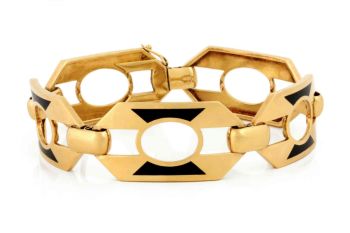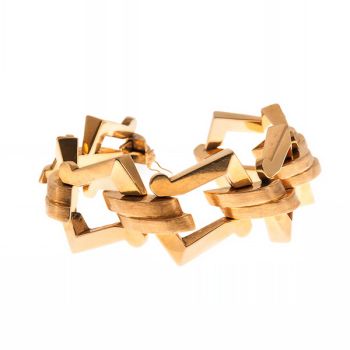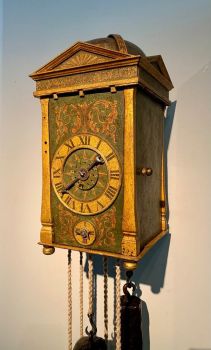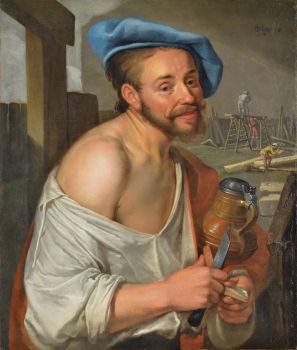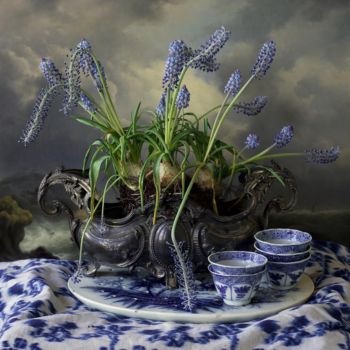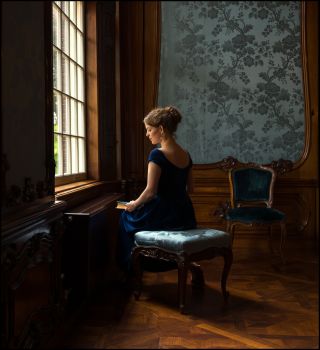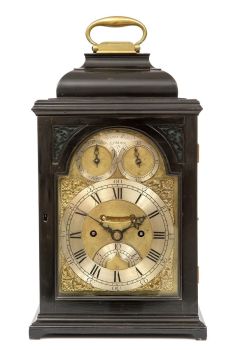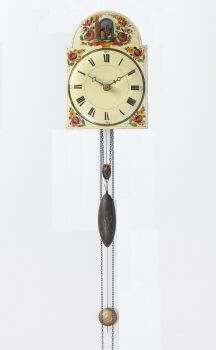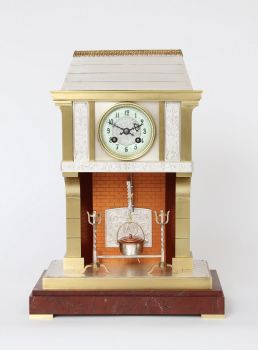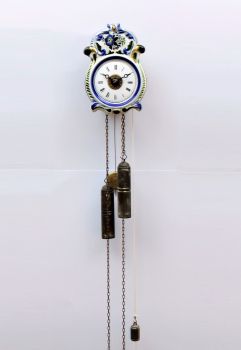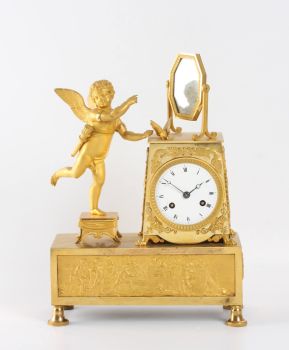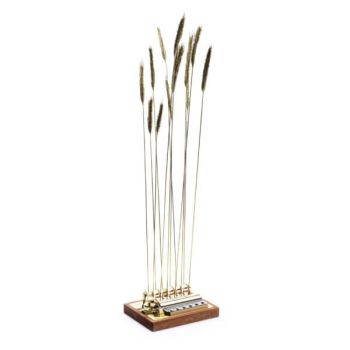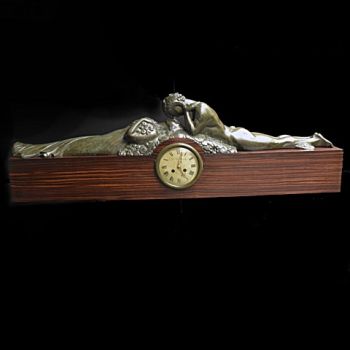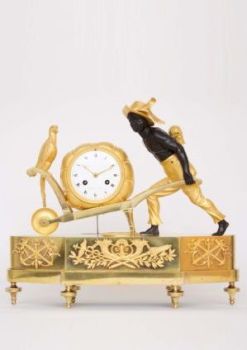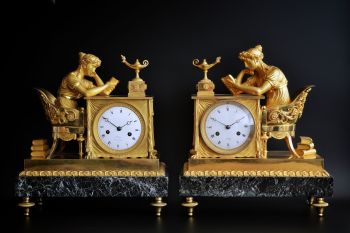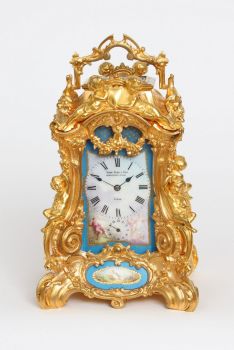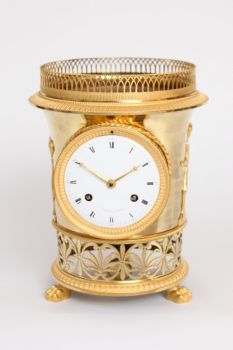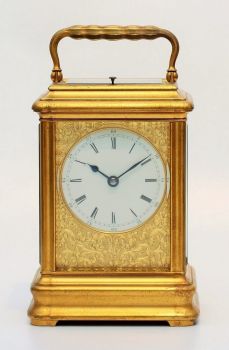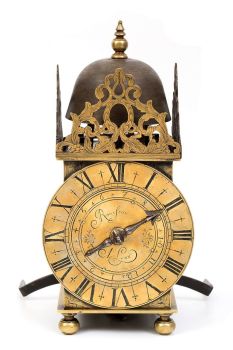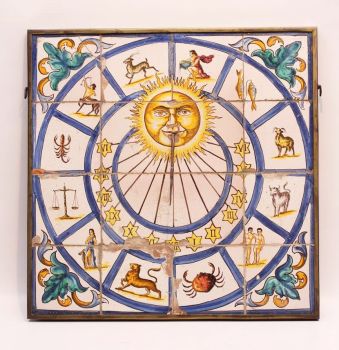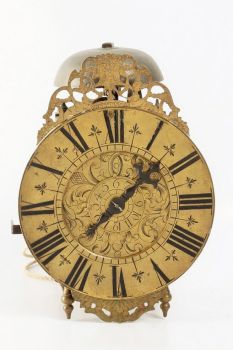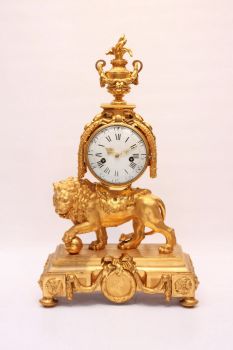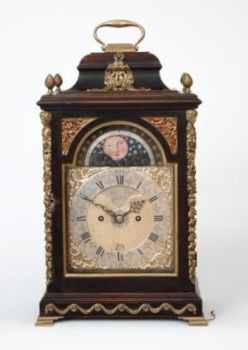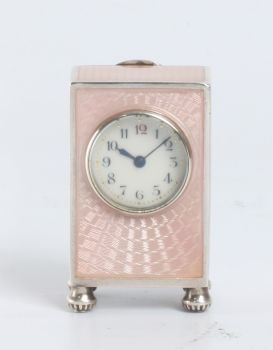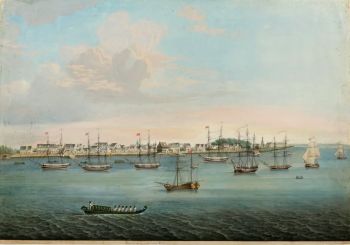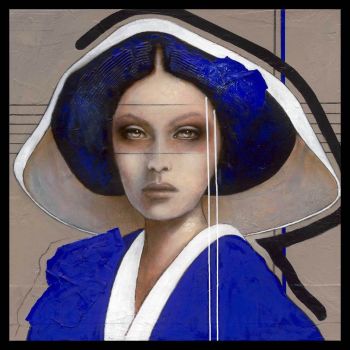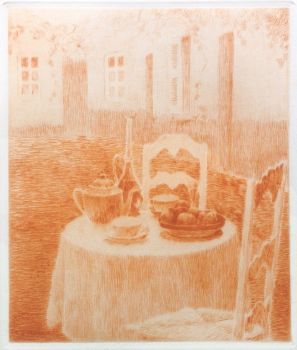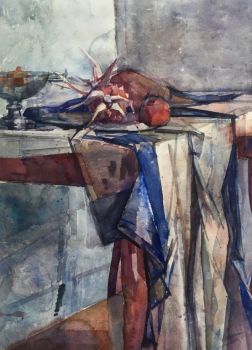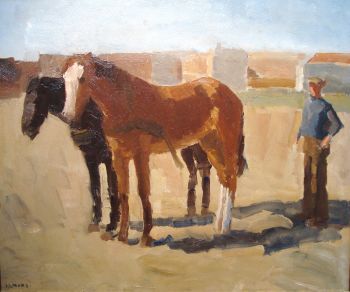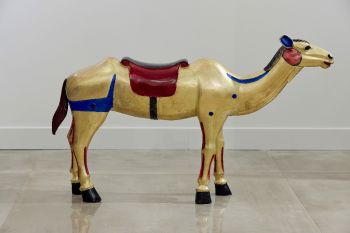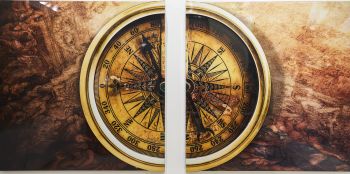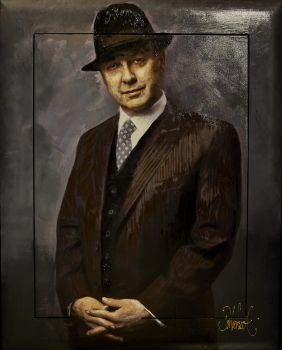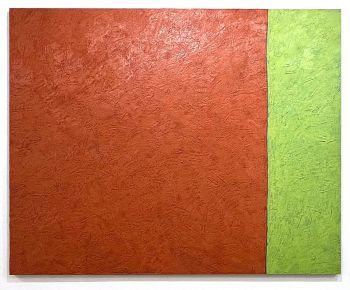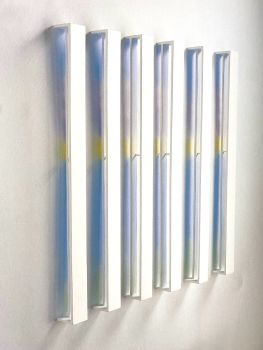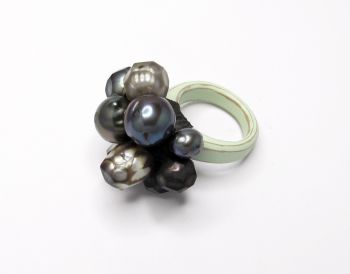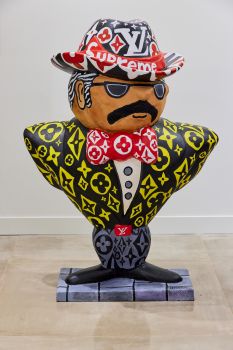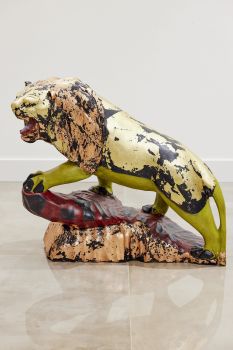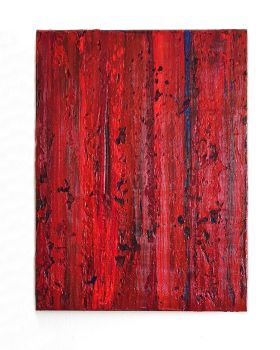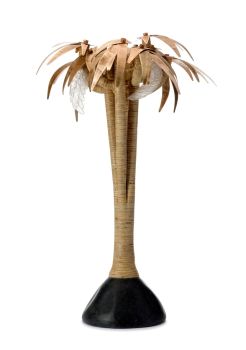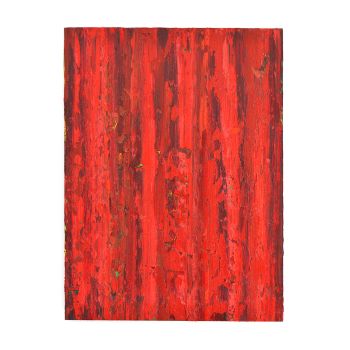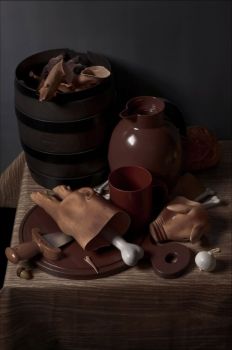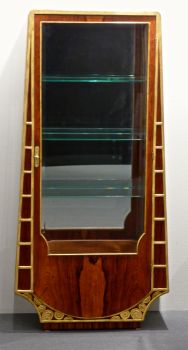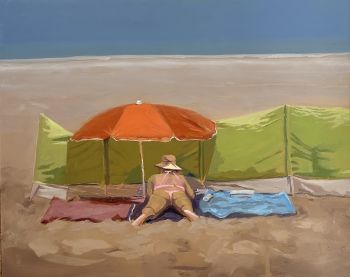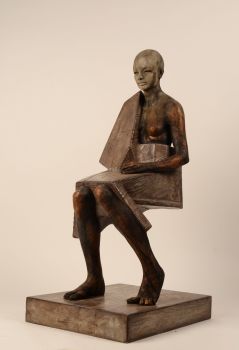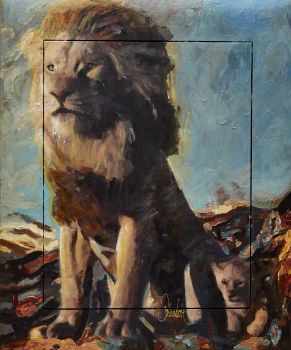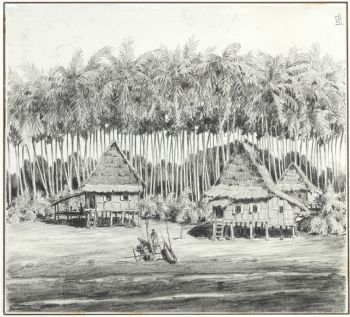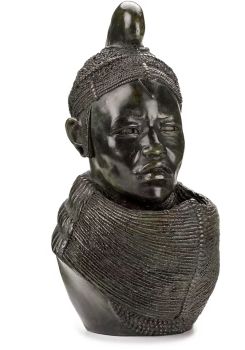A Surinam-themed Amsterdam long-case clock 1746 - 1756
Artista Sconosciuto
Legna
259 ⨯ 60 ⨯ 35 cm
Prezzo su richiesta
Zebregs & Röell - Fine Art - Antiques
- A proposito di opere d'arte
The Netherlands, 1746-1756, dial signed Nicolaas Weylandt/Amsterdam The case of the clock is made of Rio palissander veneer and snakewood, with the arch showing a painted scene of the harbour of Paramaribo, Fort Zeelandia and Dutch ships in anchorage, the spandrels decorated with figural representations of the four continents, the centre of the dial painted with Mercury, the god of trade, seated on a bale signed VCS (Vereenigde Compagnie Suriname), and one of the barrels bearing the initials “RBS,” on the left the river god of the Surinam river, with a Dutch three-master in the background. H. 259 x W. 60 x D. 35 cm (case) Diam. 32 cm (clock dial) This exceptionally rare long-case clock probably was ordered by one of the many wealthy families living along the Amsterdam canals that owned or had shares in plantations in Surinam. It’s a successful marriage of the work of an accomplished 18th century Amsterdam clockmaker, a Dutch cabinetmaker working with exotic tropical timbers, a woodcarver familiar with both Dutch rococo design and Surinamese iconography, and a painter with knowledge, whether first-hand or through other visualisations, of the Paramaribo waterfront. In the production of this Gesamtkunstwerk, only the name of the clockmaker is known: Nicloaas Weylandt (c. 1700 - 1754), who had a business situated on the Nieuwendijk near the Haarlemmersluis in Amsterdam from 1742 until his death. The case is made of imported timbers from Surinam; Rio-palissander and snakewood. A very similar clock-case, veneered in walnut, is illustrated in J. Zeeman, De Nederlandse staande klok, Zwolle, 1996, and dated c. 1740. That clock is also by Weylandt, so the case most likely also is by the same cabinetmaker working for Weylandt. Zeeman points out that 18th-century Dutch clockmakers relied extensively on imported clock parts, like the clock face, the various dials and clock hands, mainly from Britain. Besides, Amsterdam clockmakers outsourced the cabinetmaking, carving and painting to independent artisans. The Surinam character of the clock is evident not only in the timbers used, nor in the painted view of Paramaribo in the clock arch, but also very specific in the depiction of the parrots in the carved rococo centre block in the arch and the smaller carving in the door. Weylandt’s clock has a 7-day twin-barrel anchor movement, with a bell-strike on the hour and half-hour. It is fitted with a second dial, day aperture and alarm setting disk. Exhibited: De Grote Suriname Tentoonstelling, Nieuwe Kerk, Amsterdam, 5 October 2019 - 2 February 2020.
- A proposito di opere artista
Può succedere che un artista o un creatore sia sconosciuto.
Alcune opere non sono determinate da chi sono state realizzate o sono state realizzate da (un gruppo di) artigiani. Esempi sono statue dell'antichità, mobili, specchi o firme non chiare o leggibili ma anche alcune opere non sono affatto firmate.
Inoltre puoi trovare la seguente descrizione:
•"Attribuito a …." A loro avviso probabilmente opera dell'artista, almeno in parte
•“Studio di ….” o “Officina di” A loro avviso un'opera eseguita nello studio o nella bottega dell'artista, eventualmente sotto la sua supervisione
•“Cerchio di…” A loro avviso un'opera del periodo dell'artista che mostra la sua influenza, strettamente legata all'artista ma non necessariamente al suo allievo
•"Stile di..." o "Seguace di..." A loro avviso un'opera eseguita nello stile dell'artista ma non necessariamente da un allievo; può essere contemporaneo o quasi contemporaneo
•“Modalità di…” A loro avviso un'opera nello stile dell'artista ma di epoca successiva
•"Dopo …." A loro avviso una copia (di qualsiasi data) di un'opera dell'artista
•“Firmato…”, “Datato…” o “Iscritto” A loro avviso l'opera è stata firmata/datata/inscritta dall'artista. L'aggiunta di un punto interrogativo indica un elemento di dubbio
•"Con firma....", "Con data...", "Con iscrizione..." o “Riporta firma/data/iscrizione” a loro avviso la firma/data/iscrizione è stata aggiunta da qualcuno diverso dall'artista
Sei interessato ad acquistare questa opera d'arte?
Artwork details
Related artworks
- 1 - 4 / 12
Artista Sconosciuto
Een Gotische zuidelijke Nederlanden wandklok1580 - 1590
Prezzo su richiestaNico van den Assem restauratie
 A cura di
A cura diDanny Bree
Artista Sconosciuto
A superb Indonesian royal gem-set gold overlaid silver betel box19th century
Prezzo su richiestaZebregs & Röell - Fine Art - Antiques
Artista Sconosciuto
A Dutch colonial Indonesian betel box with gold mounts1750 - 1800
Prezzo su richiestaZebregs & Röell - Fine Art - Antiques
1 - 4 / 24Artista Sconosciuto
Set Franse Empire Pendules / Empire Lectura penduleearly 19th
Prezzo su richiestaKuipers Kunst & Antiek
1 - 4 / 24Artista Sconosciuto
A Dutch colonial Indonesian betel box with gold mounts1750 - 1800
Prezzo su richiestaZebregs & Röell - Fine Art - Antiques
Artista Sconosciuto
A superb Indonesian royal gem-set gold overlaid silver betel box19th century
Prezzo su richiestaZebregs & Röell - Fine Art - Antiques
Artista Sconosciuto
Japanese transition-style lacquer coffer 1640 - 1650
Prezzo su richiestaZebregs & Röell - Fine Art - Antiques
Gyrinus
Verre gravé pointillé avec putti1764 - 1766
Prezzo su richiestaPeter Korf de Gidts - Antiquairs
1 - 4 / 24- 1 - 4 / 24
Artista Sconosciuto
UN RARO GRANDE TELESCOPIO GIAPPONESE IN PELLE LACCATA1750 - 1800
Prezzo su richiestaZebregs & Röell - Fine Art - Antiques
Artista Sconosciuto
COPPETTA CROGIOLO PICCOLA SAWASA GIAPPONESE 'FORMA PESCA'early 18th
Prezzo su richiestaZebregs & Röell - Fine Art - Antiques
Philip Reeves
A Massai/Rendille tribe girl from Kenya1952
Prezzo su richiestaZebregs & Röell - Fine Art - Antiques
Artista Sconosciuto
A Dutch colonial Indonesian betel box with gold mounts1750 - 1800
Prezzo su richiestaZebregs & Röell - Fine Art - Antiques
Thea G.F. Eschauzier
Ritratto di una ragazza giavanese1931
Prezzo su richiestaZebregs & Röell - Fine Art - Antiques
1 - 4 / 12












